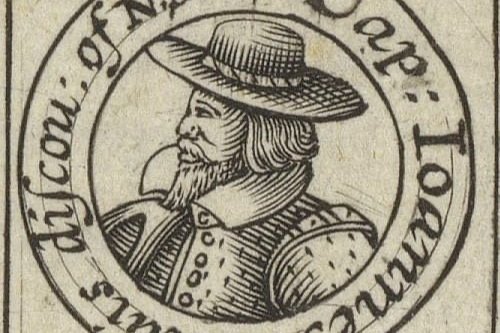Falklands Day-vis
By ASH Smyth
August 2022
It’s Falklands Day today, the celebration of the first recorded (British) sighting of the Falkland Islands, by John Davis, on August 14th 1592.
Born in Devon circa 1550, beside the waters of the Dart, John Davis spent his childhood messing about on the river in the company of such minor notables as Adrian and Humphrey Gilbert (pioneering Elizabethan colonist of North America and Ireland), and their half-brother, Walter Raleigh, as well as the court occultist, Dr John Dee.
He went to sea young, and by his mid- to late-30s had embarked on three expeditions to find the Northwest Passage (to China, it was hoped), commanded a ship against the Armada in 1588, and sailed against the Spanish again in the Azores conflict.
In 1592 he was captaining the 120-ton ship Desire, as part of Sir Thomas Cavendish’s expedition to discover the Northwest Passage from the other side (i.e. around Alaska), when most of the ships had to abandon the expedition. Davis elected to take the Desire and one other vessel and attempt the passage of the Straits of Magellan on his own account.
He too was unsuccessful. ‘The ninth,’ he wrote, ‘wee had a sore storme, so that wee were constrained to hull, for our sailes were not to indure any force. The 14 we were driven in among certaine Isles never before discovered by any knowen relation, lying fiftie leagues or better from the shoare, East and Northerly from The Streights: in which place, unlesse it had pleased God of his wonderfull mercie to have ceased the winde, wee must of necessitie have perished. But the winde shifting to the East, wee directed our course for The Streights, and the 18 of August wee fell with the Cape in a very thick fogge…’
These ‘certaine Isles,’ wrote his editor Admiral Sir Albert Markham (FRGS) in 1880, were ‘undoubtedly the Falkland Islands’.
“Falklands Day was formally downgraded twenty years ago, by order of Executive Council, to allow for the re-introduction of Peat Cutting Monday.”
But ‘knowen’ to Davis or not, there is ‘very conclusive evidence’, Markham acknowledged, ‘to prove that the [as-yet unnamed] Islands had been discovered long before the time of Davis’, albeit ‘by whom it is difficult to decide.’
‘The honour of their discovery,’ Markham deduces, ‘must belong to some unknown foreign navigator’, since the islands appear, sometimes described as ‘the Ascension Islands’, on a good half-dozen European maps, charts and globes produced in the 65 years or so preceding Davis’s windswept arrival.
Given that Richard Hawkins would happen upon the archipelago, as well, just two years after Davis, it is perhaps also slightly improbable that no mariner (of any nationality) set foot on the Islands for almost another century, when John Strong of the Welfare made the first recorded landing in January 1690.
Nevertheless, The Falklands’ motto – ‘Desire the right’ – retains its nod to John Davis to the present day, and the current flag incorporates a likeness of the ship.
Until relatively recently, Falklands Day was also a, if not the, national holiday. It was apparently formally downgraded twenty years ago, by order of Executive Council, to allow for the re-introduction of Peat Cutting Monday, in October. Liberation Day (June 14th) has largely taken its place as the principal day of national observance.
Davis’s account of his South Atlantic journey was published in 1600, in London, by Richard Hakluyt. By that time, Davis had sailed with Raleigh to Cadiz, and the Azores again, and served as pilot on an expedition to Sumatra, for the Dutch East India Company. In 1601 he sailed, as Pilot-Major, on Sir James Lancaster’s first voyage of/for the English East India Company.
Between trips, he wrote The Seaman’s Secret (1594), a treatise on celestial navigation, and The World’s Hydrographical Description (1595), detailing his findings and theories of the Northwest Passage. He also invented a device for determining latitude by reading the angle of elevation of the sun. The backstaff, or Davis quadrant, remained in widespread use for another 150 years.
In In Patagonia, the always-suspect storyteller Bruce Chatwin claims that Captain Davis arrived home, barely alive, from his horrendous journey South, only to find his wife (whose name, unimprovably, was Faith) had taken up with a ‘sleek paramour’, allegedly a counterfeiter, with whom she conspired to rip him off. He also sees in Davis a potential model for Coleridge’s Ancient Mariner.
‘Restlessness got him in the end,’ says Chatwin – and like so many sailors before and since, John Davis ended up dying far from home, killed by Japanese pirates on a third and very final journey to the East Indies. These days he is commemorated in just a few maps, documents, and the occasional street name.


